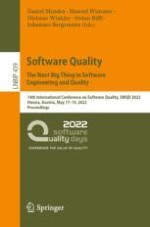This book constitutes the refereed proceedings of the 14th Software Quality Days Conference, SWQD 2022, held in Vienna, Austria, during May 17-19, 2022.
The Software Quality Days (SWQD) conference started in 2009 and has grown to the biggest conference on software quality in Europe. The program of the SWQD conference is designed to encompass a stimulating mixture of practical presentations and new research topics in scientific presentations. The guiding conference topic of the SWQD 2022 is “What's The Next Big Thing in Software Engineering and Quality?”.
The 4 full papers presented in this volume were carefully reviewed and selected from 8 submissions. The contributions were organized in two topical sections named: AI in Software Engineering; and Quality Assurance for Software-Intensive Systems. The book also contains two invited talks.
